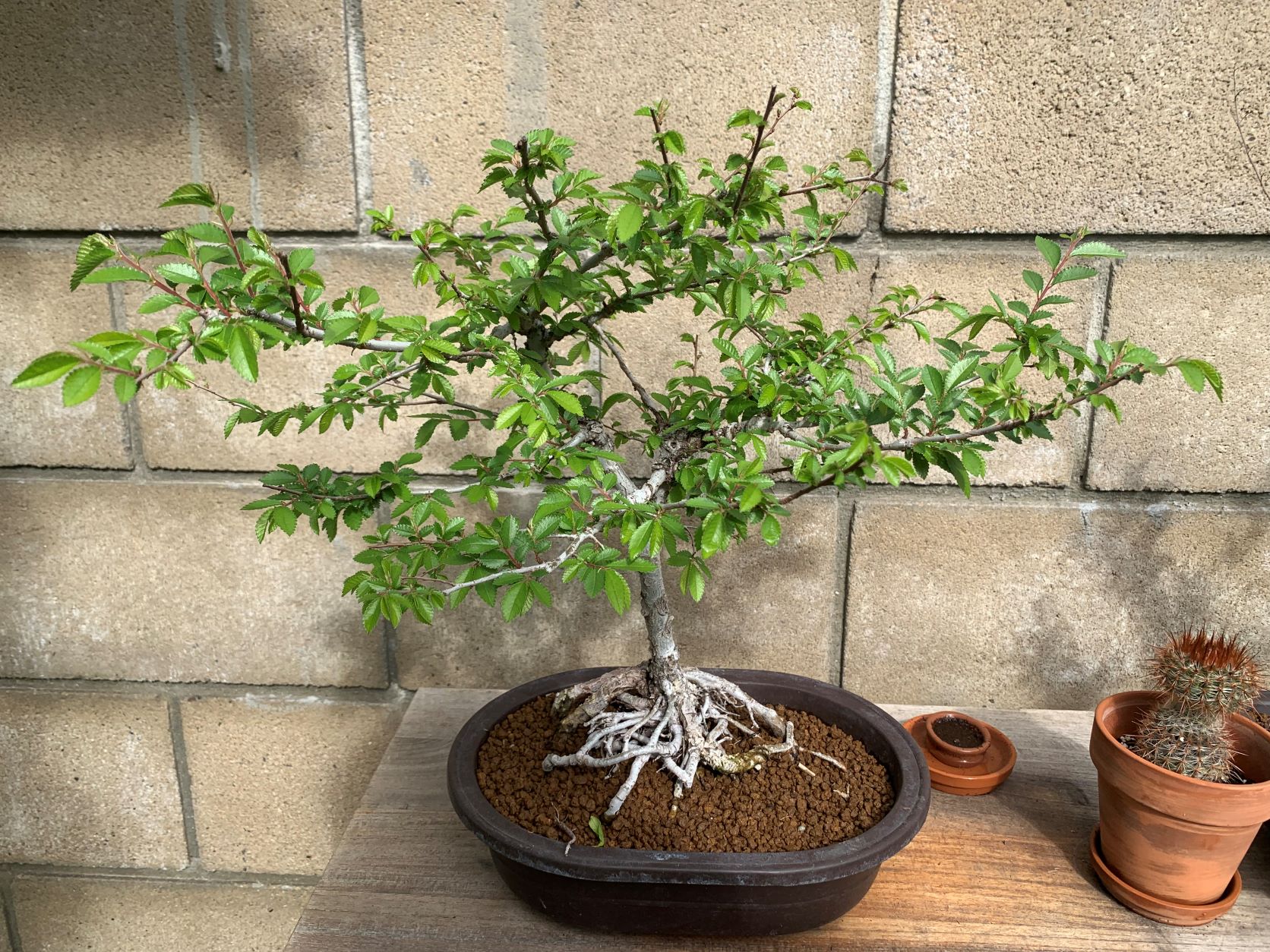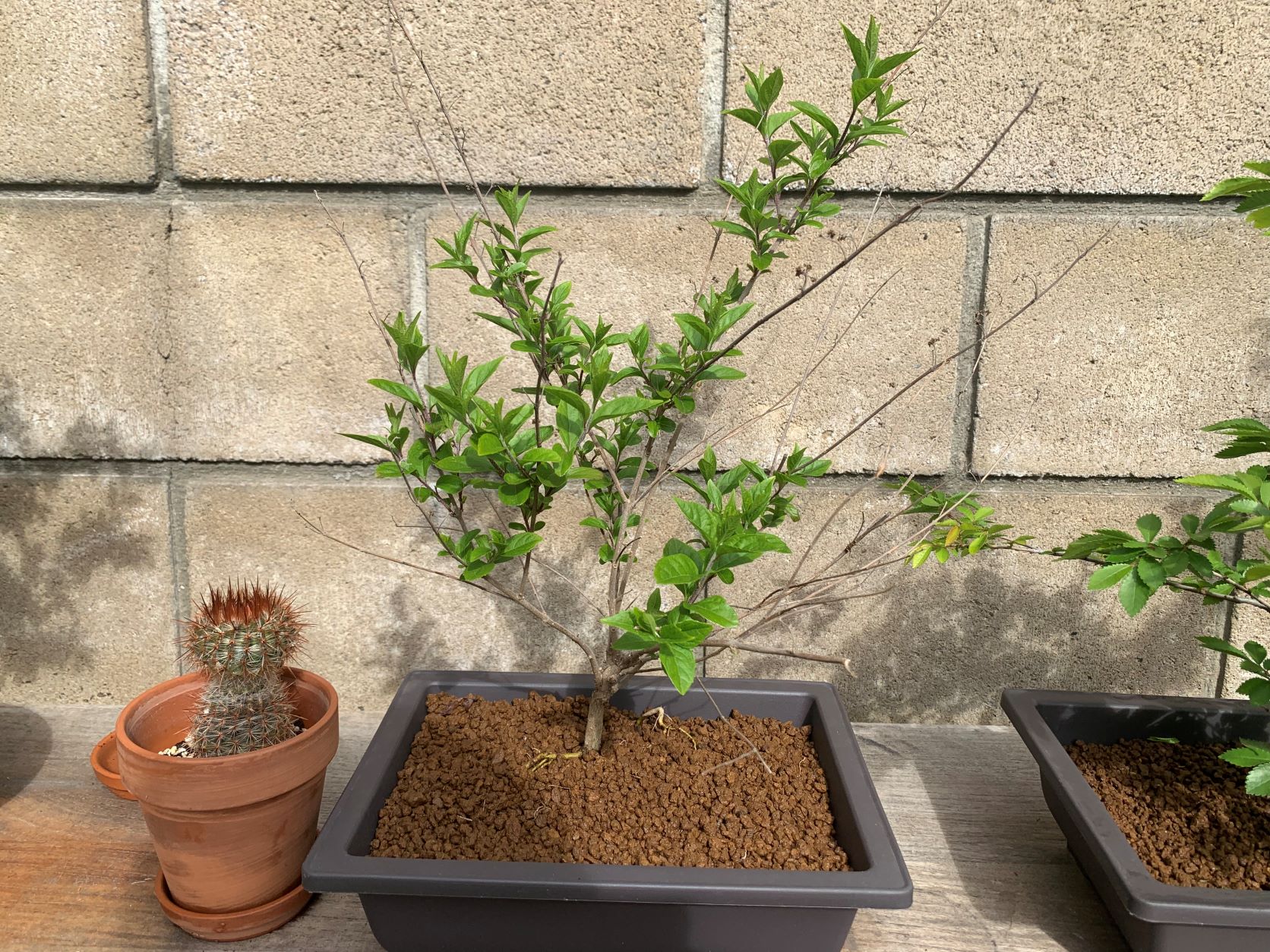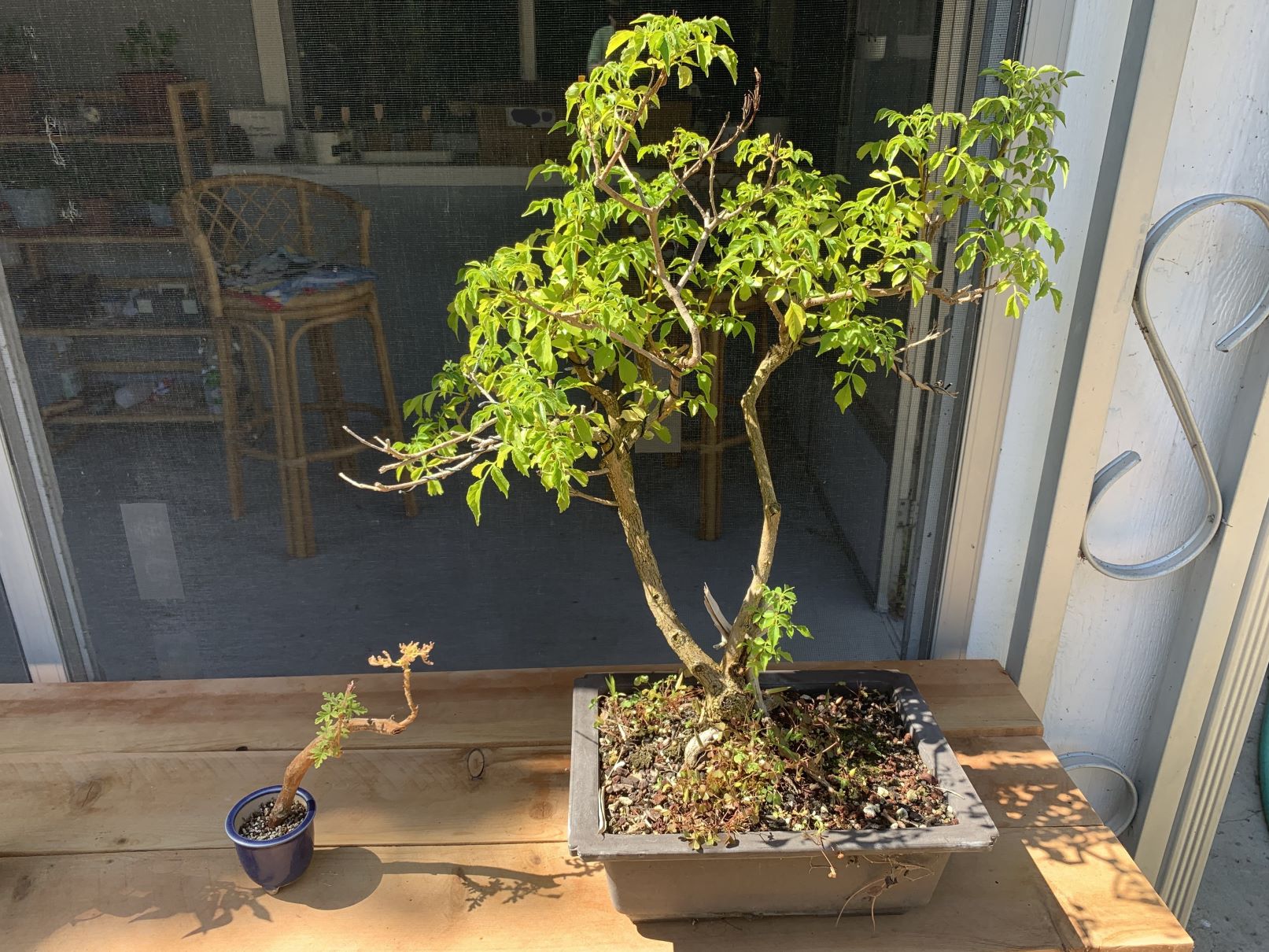bonsai.
"All art is a proxy for something else. And I feel that bonsai, if not overtly figural, is at least a proxy for our hopes of the future, as a post-dated love letter."
— Michael Hagedorn
This is a collection of notes about each type of bonsai tree I own and guides for care collected from various sources. I have always had an appreciation of bonsai and Japanese gardening, but these became a more serious interest sometime in 2019 and I acquired my first tree in early 2020. I remain a beginner, especially not having any outdoor space to utilize for the hobby until 2022, but I'm excited to grow more now without the limitation.
In 2024 I joined my local bonsai club and am learning at a much more rapid pace than I was before, and now that I've internalized more of the basics I am restructuring this page to include less general information and more notes about my specific trees as I learn them.
bonsai in training.
chinese elm ("elmer")

Photo: Mar 2023
- Acquired in January 2020 from Kimura Bonsai at their former location in Northridge, CA. This was is my first tree which I kept alive indoors under grow lamps in our 1-bedroom apartment until June 2022 when we were able to move to a place with outdoor space. It's much happier to be outdoors now, but I am now in the process of re-training it as I need to develop the trunk more before concerning myself with the branch structure like I was previously trying to.
- Styling notes: Not sure yet! In the process of rethinking its entire design. I love the existing nebari, so I definitely want to keep developing that.
- Last repotting - Late Jan 2025: Repotted into oversized grow box to spread roots and develop nebari.
- Sunlight - Full sun: Chinese elms need a lot of light. Placing somewhere it can be exposed to morning sunlight is better due to its low intensity. Direct afternoon sunlight in summers can cause burns in the leaves.
- Growing season: Buds sprout in mid-March.
- Dormant season: Chinese elms don't need a dormant period and generally adapt to their climate. Does go dormant for parts of the year, but will also sprout out some leaves occasionally during the warmer weeks of winter.
japanese beautyberry (callicarpa japonica)

Photo: Mar 2023
- Acquired in January 2023 from Kimura Bonsai (Kashi no Ki-en Garden) in Castaic, CA.
- Not a lot of solid information out there that I've been able to find about this tree as a bonsai.
- Styling notes: Beautyberry at maturity is an irregular upright form with graceful arching branches, so I want to emulate that. Grows flowers and purple berries during the summer. I've noticed that new branches take a long time to lignify, and fully lignified branches are too brittle to wire. Can only clip and grow, will take a long time to develop.
- Last repotting - Late Jan 2025
- Sunlight - Shade/Partial: Seems to prefer shade/partial shade. Developed leaf scorch in full sun during July, moved to shade and began growing berries and flowers again almost immediately.
- Growing season: Begins sprouting in early-mid March.
- Dormant season: Goes dormant around November.

Photo: May 2024
honeysuckle (lonicera japonica)
- Acquired in May 2024 from local bonsai club raffle.
- Styling notes: This one came nicely styled already with a deadwood feature near the base. The leaves and flowers develop naturally into sort of "pom-pom" shapes, so I want to lean into that over time to create a lot of pads.
- Last repotting - Unsure: Repot in spring or fall, every 2-3 years when roots are reaching out near the bottom of the pot.
- Sunlight - Full sun
- Growing season: Year-round.
- Dormant season: Evergreen shrub.
p afra
- Acquired in May 2024 from bonsai club raffle.
- Styling notes: Came styled as a forest in a nursery pot, going to keep it as a forest after repotting into grow box.
- Last repotting - Mid April 2025
- Sunlight - Full sun
- Watering: Succulent that doesn't require frequent watering.
- Growing season: Year-round.
- Dormant season: Evergreen succulent.
pomegranate
- Acquired in Sept or Oct 2024 from bonsai club raffle.
- Styling notes: Comes from a thick cutting so the trunk is a bit stubby. Waiting for more vigorous growth before making styling decisions.
- Last repotting - Late Jan 2025
- Sunlight - Full sun
- Growing season: Spring through fall.
- Dormant season: Winter, but occasionally still sprouts leaves during warmer weeks.
nana junipers
- Acquired in Nov 2024 from local nursery.
- Styling notes: These are still quite young, going to try wiring branches into interesting shapes as early as possible but far from envisioning the final shape of the trees.
- Last repotting - Late Jan 2025
- Sunlight - Full sun
- Growing season: Grows year-round, but most vigorous growth in spring through summer.
- Dormant season: Evergreen.
pyracantha
- Acquired in Nov 2024 from local nursery.
- Styling notes: Not yet started styling, want to use its current trunk shape but need to research more for possible styles.
- Last repotting - Late Jan 2025
- Sunlight - Full sun
- Growing season: Year-round.
- Dormant season: Evergreen.
japanese maple
- Acquired in Jan 2024 from local nursery.
- Styling notes: Growth is dense and not much movement in the trunk, so looking at broom style.
- Last repotting - Late Jan 2025
- Sunlight - Shade/Partial sun: Is vulnerable to full sun during hottest months.
- Growing season: Grows visible buds in the fall and winter which don't push out until the spring.
- Dormant season: Goes dormant around late october.
rosemary
- Propagated in Mar 2025 from cuttings in garden.
- Styling notes: Club president has a beautiful rosemary bonsai that he brings to meetings sometimes, and it smells like heaven when it gets trimmed.
- Last repotting - Late Mar 2025
- Sunlight - Full sun
- Growing season: Year-round.
- Dormant season: Evergreen shrub.
liquidambar (sweetgum)
- Acquired in June 2024 from local nursery.
- Styling notes: None yet, in small nursery pot so will be letting grow out and repotting next spring.
- Last repotting - None
- Sunlight - Full: Provide some cover midday during hottest months.
- Growing season: Spring through fall.
- Dormant season: Goes dormant in winter.
shimpaku juniper
- Acquired in June 2024 from local nursery.
- Styling notes: Going for semi-cascade or informal upright.
- Last repotting - None
- Sunlight - Full
- Growing season: Grows year-round, but most vigorous growth in spring through summer.
- Dormant season: Evergreen.
other notes.
bonsai wishlist/todo:
- Bougainvillea (have but needs repotting)
- Kotohime maple
- Wisteria
- Hokkaido elm
- Coast redwood
- Paperbark tree (grew up around these in southern California, curious about trying to bonsai one)
soil and fertilizer:
- Standard mix for conifers but good for all trees in training: Even mix between large grain pumice, red lava rock, and pinebark. Add akadama to mix and orchid/sphagnum moss on top for trees not in training. Can also increase ratio up to 50% with pinebark/akadama or cactus mix because they hold water better.
- Large grain pumice use 3/16ths size for smaller trees, 3/8ths for larger.
- For trees in training: Good easy fertilizer during growing season is Bioadvanced Osmocote every 3 months. Releases faster with water and heat, so more fertilizer is released from pellets during warm season when the bonsai is also getting more water.
- For conifers: Fish and kelp emulation for fertilizer once a month (recommended Organic Fish and Kelp Liquid Fertilizer by Kellogg Garden Organics). Can also use as a foliar feed diluted in spray bottle.
- For elms: Bioadvanced Rose & Flower Care - Use in October at start of dormancy, leaves come back tiny and more proportional in the spring
- For rosemary: Prefers sandy loam soil, use mix of sandy soil and training mix.
- For trees not in training: Blood meal, bone meal, cottonseed meal mix makes for a good organic fertilizer, put in teabags on top of soil and water on top of them to release
watering guide for bonsai-sitters:
- The bonsai in winter dormancy will most likely each need watering every 2-3 days if it hasn't rained. If the soil still seems damp on the second day wait till the 3rd. If it gets hot out (80+ degrees) check to see every day if the soil has dried out faster and water more if needed.
- In the summer, expect to water every day. If the soil is still damp about an inch deep, consider delaying watering for another day or half day. In especially hot weather, multiple waterings in a single day may be required. The exception to this are pre-bonsai in oversized grow boxes, which generally retain enough water for 1.5 to 2 days at minimum.
- Soak the soil until it's completely wet and water is running out the bottom of the pot. Standard training mix as outlined above is difficult to over-water because of its excellent drainage.
